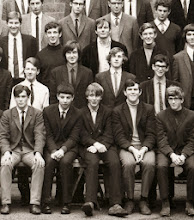Goodness, sorry (again). It's been more than a month. I really apologise; it's been the election and this and that and the fact that the moth trap is up and running again and I can't resist doing blog entries for Martin's Moths (check out via the profile section on this page, and enter a new world).
I'm also a bit de-motivated by the lack of controversy about my assault on the Grimsters. This isn't just here on the blog, but I've been surprised at talks I've done in Newcastle and Hexham, that there hasn't been more of a fightback by the old Northern guard. At Northern Stage, they put up a lot of the gritty grey photos which have so dominated the Northern canon and we had quite a good discussion about that. But most people seem to be taking my Cheer Up Everyone trumpet calls like lambs. I must just show you my own grim and gritty slide which I showed at Newcastle (satirically, in the same breath as telling everyone how unsurprised I was to be staying at the Grey hotel in Grey Street). That was unfair, mind. It just happened to be Earl Grey rather than Earl Light, although his tea is notably lighter than the standard dark brew.

I took this pic in March and when I went back at the end of April for the Northern Stage talk, the slogan had been sprayed over. But it is a good question. I must find out why the hideous but strangely beguiling walkway below the High Level Brdidge came to such a sudden stop. The metal edge of the HLB, far above, is encrusted with dead pigeons incidentally. I wonder if the Kittiwakes got them.
However, the bibliography must press on, and here are another three publications which I have learned from and enjoyed.

Some years ago, I went for a walk in Buck Wood, above the river Aire and Esholt sewage works near here, an area much pleasanter than it sounds. My stumbling across some old foundations led to making a Radio 4 programme on open air schools, because the concrete traces are all that is left of Thackley Open Air School. The programme in turn reinforced Christine Alvin's intention of writing a book on the place, about which she knows much. The result is
The School in the Wood, Friends of Buck Wood 2008, which you can get direct from fobw@ncalvin.f9.co.uk.
Thackley is a comfortable and lovely spot. The centre of Bradford has notorious problems, with a huge hole where the Westfield development has run out of private cash.

The easing of the recession (fingers crossed) should see work start again, but meanwhile the city council is bravely pressing on with its plans for a mirror pool the other side of the City Hall. Excavators are already at work. You can read all about the underlying thinking in
Bradford Centre Regeneration Masterplan, Will Alsop Architects, 2003, probably not easy to get hold of but Bradford council or Alsop's should be able to point you in the right direction.
Finally for now, I like detailed books by enthusiast for recondite subjects, which often contain unexpected wider social issues overlooked by more general historians.

One such is B
radford City Tramways 1882-1950 by D M Coates, Wyvern Publications 1984. It helped me, too, when I was tracking down the former workshop of Bill Cull, the man who made Issigonis' Mini work with his continuous velocity joints - see
A Mini Adventure by myself, Aurum Press 2009, if you want to know more...

 Towards the end of True North there's a section on the numinous nature of the region's wild landscape. Religious or not, visitors are seldom unmoved by landscapes such as Lindisfarne, or Holy Island, and shrines such as the little chapel of the 'Four Cs', saints Cedd, Chad, Caewlin and Cynebil, at Lastingham. One regular walker is the rock musician Julian Cope (The Teardrop Explodes, Brain Donor et al) who is greatly interested in other rocks - the mysterious monoliths and stone circles left by our ancestors in the distant past.
Towards the end of True North there's a section on the numinous nature of the region's wild landscape. Religious or not, visitors are seldom unmoved by landscapes such as Lindisfarne, or Holy Island, and shrines such as the little chapel of the 'Four Cs', saints Cedd, Chad, Caewlin and Cynebil, at Lastingham. One regular walker is the rock musician Julian Cope (The Teardrop Explodes, Brain Donor et al) who is greatly interested in other rocks - the mysterious monoliths and stone circles left by our ancestors in the distant past.

















































